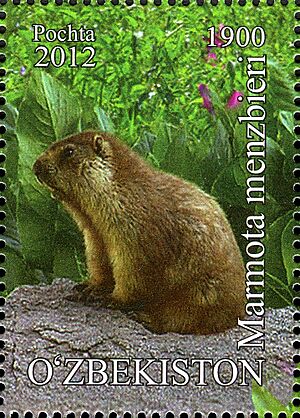Menzbier's marmot facts for kids
Quick facts for kids Menzbier's marmot |
|
|---|---|
 |
|
| On Uzbek stamp | |
| Conservation status | |
| Scientific classification | |
| Genus: |
Marmota
|
| Species: |
menzbieri
|
The Menzbier's marmot (Marmota menzbieri) is a type of rodent that lives in Central Asia. It belongs to the Sciuridae family, which includes squirrels and groundhogs. This marmot was named after a Russian zoologist, Mikhail Aleksandrovich Menzbier.
Contents
Where Menzbier's Marmots Live
Menzbier's marmots make their homes in meadows and steppes. These areas are found high up in the mountains, usually between 2,000 and 3,600 meters (about 6,500 to 11,800 feet) above sea level. You can find them in the western Tien Shan Mountains. This mountain range stretches across several countries. These countries include Kazakhstan, Kyrgyzstan, Uzbekistan, and a small part of northern Tajikistan.
Why Menzbier's Marmots Need Our Help
The Menzbier's marmot has the smallest living area of all marmots in Europe and Asia. There are not many of them, and they live far apart. In 1998, scientists thought there were about 22,000 of these marmots in total. By 2005, estimates showed about 20,000 to 25,000 in Kazakhstan alone.
The IUCN (International Union for Conservation of Nature) says this marmot is a vulnerable species. This means it is at risk of disappearing. The biggest problem for them is that their homes are being lost. This happens as more land is used for farming. People also hunt them for food, which is another threat.
Sometimes, the Menzbier's marmot lives near the long-tailed marmot. Even though they are related, they prefer different places. Menzbier's marmots like wetter areas that are higher up. They also prefer places with shorter grass.
What Menzbier's Marmots Look Like
The Menzbier's marmot is the smallest marmot in Europe and Asia. Its body is about 34.5 to 50 centimeters (13.5 to 19.5 inches) long. It can weigh from 1.85 to 5 kilograms (about 4 to 11 pounds). It has a short tail and thick, fluffy fur.
This marmot has a special look that sets it apart. Its upper body and back are dark. These dark parts stand out against its pale belly and front. As the year goes on, their fur usually gets a bit darker overall.
Menzbier's Marmot Family and Life Cycle
The areas where Menzbier's marmots live are split into two by the Pskem River. This river creates a valley that separates them. Even though the marmots on both sides look very similar, they are different genetically. This means scientists recognize two types, or subspecies, of Menzbier's marmots. The northern group is called M. m. menzbieri. The southern group is called M. m. zachidovi.
Like other marmots, Menzbier's marmots hibernate for a long time. They go into a deep sleep from August or September until April or May. This helps them survive the cold winter months when food is scarce.


